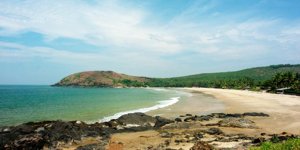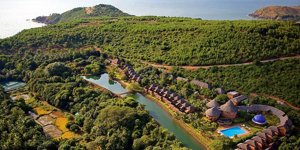Gokarna, Karnataka is a unique coastal town known for its sacred temples, stunning beaches, rich culture, and profound mythological history. Situated along the Arabian Sea in Uttara Kannada district, Gokarna’s allure stems from its religious significance and serene landscapes, making it a favorite for pilgrims, backpackers, and leisure travelers alike.
Key Details:
| Category | Details / Major Options | Distance from Center | Typical Cost (INR) |
|---|---|---|---|
| Beach | Om Beach | 1 km | Free entry |
| Beach | Kudle Beach | 1 km | Free entry |
| Beach | Paradise Beach | 4 km | Free entry, must trek |
| Beach | Half Moon Beach | 2 km | Free entry |
| Beach | Gokarna Main Beach | 1 km | Free entry |
| Temple | Mahabaleshwar Temple | 1 km | Free entry |
| Temple | Maha Ganapati Temple | 1 km | Free entry |
| Temple | Bhadrakali Temple | 18 km | Free entry |
| Fort | Mirjan Fort | 13 km | ₹10-₹20 entry |
| Cave/Nature | Yana Caves, Vibhuthi Falls | 56 km/13 km | Free entry |
| Water Sports | Water sports at beaches | 2 km | ₹500-₹1,500 per activity |
| Trekking | Beach trekking | 4 km | Guided treks ₹300-₹800 |
| Shopping | Local flea markets & handicrafts | 1 km | ₹100-₹1,000 (typical spend) |
| Food & Drink | Beach shacks, cafes, local cuisine | 3 km | ₹150-₹500 per meal |
| Transportation | Rickshaw/local taxi | – | ₹50-₹300 within town |
| Accommodation | Budget hostels/guesthouses | – | ₹400-₹1,500/night |
| Accommodation | Mid-range hotels | – | ₹1,500-₹3,000/night |
| Accommodation | Beach resorts | – | ₹2,500-₹6,000/night |
| Road (from Bengaluru) | KSRTC bus/private taxi | 490 km | Bus ₹800-₹1,500, Taxi ₹5,000+ |
| Road (from Goa) | Taxi/bus | 106 km | Taxi ₹2,500+, Bus ₹500-₹900 |
| Rail | Gokarna Road or Ankola station | 10-20 km | ₹200-₹1,200 (varies by class) |
| Air | Goa International Airport | 106 km | Taxi ₹2,500+, Bus ₹600+ |
History of Gokarna
Gokarna’s origins are steeped in legend. Its name, which means “Cow’s Ear” in Sanskrit, derives from the mythical tale where Lord Shiva emerged from the ear of a cow here to bless the land. The town’s most cherished legend revolves around the Atma Linga of Lord Shiva. As the story unfolds, Ravana, the demon king, desired the Atma Linga for his mother and was rewarded with it after intense penance. He was instructed never to place it on the ground; however, Lord Ganesha, disguised as a Brahmin boy, tricked Ravana and placed the Linga in Gokarna, cementing the town’s status as one of the holiest sites for Shiva devotees.
Historically, it was part of the ancient Sodhe and Vijayanagara kingdoms, referenced in several Puranas like the Skanda Purana and Bhagavata Purana. Its transformation from a sacred site to a vibrant tourist destination occurred over centuries, blending mythological significance with natural beauty.
Cultural Heritage
Gokarna is often referred to as the “Kashi of the South”, illustrating its spiritual prominence. Ancient temples such as the Mahabaleshwar Temple, founded in the 4th century, and the Maha Ganapati Temple are the centerpieces of it’s devotion and architectural brilliance. Festivals, especially Maha Shivratri, attract lakhs of pilgrims who come to witness traditional rituals and vibrant celebrations.
The town’s culture is a fusion of Konkan, Karavali, tribal, and North Karnataka influences. The local population upholds customs with community-wide events, weekly flea markets, and handcrafted artifacts that exhibit regional artistry. The enduring spiritual atmosphere and wellness trends have transformed Gokarna into a sought-after yoga destination as well.
Tourist Spots
It is famed for its spectacular beaches, Om Beach, Kudle Beach, Half Moon Beach, Paradise Beach, and Gokarna Main Beach, ideal for relaxation, trekking, and water sports. Nature lovers revel in the serene settings surrounded by coconut palms and coastal cliffs. Other draws include:
- Mahabaleshwar Temple: Revered for its Atma Linga.
- Maha Ganapati Temple: Associated with the Ravana legend.
- Mirjan Fort: Historic ruins enveloped by greenery.
- Koti Tirtha: Sacred water tank for religious rituals.
- Yana Caves and Vibhuthi Falls: Unique geological and natural sites.
- Bhadrakali Temple and Shiva Cave: Spiritual landmarks.
The surrounding areas, Karwar for water sports and Honnavar for backwater boating, complement it’s offerings for adventure seekers.
Best Routes
Gokarna can be accessed via road, rail, and air:
- By Train: The nearest station is Gokarna Road, approximately 10 km from town, serviced by the Konkan Railway. Trains run from Mumbai, Mangalore, and Bengaluru.
- By Road: KSRTC and private buses connect Gokarna with Bengaluru (10 hours), Goa (140 km), and other major cities. The most preferred road trip from Goa takes less than 6 hours via NH66.
- By Air: The nearest airports are Goa International (150 km), Mangalore International, and Hubli Domestic. Taxi and bus services are available onward to Gokarna.

Tourism Revenue and Economic Impact
Tourism is the backbone of Gokarna’s economy, with over 1.3 million annual visitors and an estimated population of just 13,000. The town maintains its rustic charm while accommodating New Age travelers, spiritual seekers, and leisure tourists.
It’s emergence as a travel hotspot has generated revenue streams through hospitality, transport, craft markets, and guided tours. Local businesses, cafés, guest houses, and adventure operators, benefit from steady tourist inflow. Community efforts help preserve its religious and ecological environments, ensuring the destination’s longevity.
Location and Climate
Gokarna is located at latitude 14.55°N and longitude 74.31667°E, bordered by the Gangavali and Aghanashini rivers, on Karnataka’s Arabian Sea coast. It’s 238 km north of Mangalore and 483 km from Bengaluru. Neighboring villages like Bankikodla-Hanehalli, Sanikatta, and Tadadi add to its local charm.
The climate is tropical, with moderate winters (minimum 20°C) and humid, rainy summers. The monsoon season (June to September) sees the highest rainfall, while October to March offers pleasant weather ideal for travel.
FAQs About Gokarna
What is Gokarna famous for?
It is renowned for its sacred temples and unspoiled beaches, attracting both pilgrims and adventure travelers for spiritual solace and natural beauty.
What is the best time to visit Gokarna?
October to March, when the weather is pleasant and ideal for outdoor activities, is the preferred season for visiting Gokarna.
How can one reach Gokarna?
It is accessible by train, bus, and taxi from Bengaluru, Goa, and Mangalore. The nearest railway station is Gokarna Road, and Goa International Airport is the closest major air hub.
Which are the top tourist spots in Gokarna?
Popular spots include Om Beach, Kudle Beach, Mahabaleshwar Temple, Maha Ganapati Temple, Mirjan Fort, and Yana Caves, offering a blend of religious sites and adventure opportunities.
Is Gokarna suitable for family vacations?
Absolutely. Gokarna offers a relaxed, safe environment with historical sites, serene beaches, and varied activities, making it enjoyable for families, solo travelers, and groups alike.
What are the unique cultural traditions of Gokarna?
It’s culture is a vibrant mix of Konkan, Karavali, tribal, and North Karnataka influences. Regular festivals, handicrafts, and wellness programs create a lively atmosphere for visitors and locals.
How does tourism impact Gokarna’s economy?
Tourism is a major economic driver, supporting local businesses through hospitality, retail, and religious tourism. Community initiatives help protect cultural heritage and ecological integrity.
Conclusion
Gokarna, Karnataka stands out as an enchanting fusion of mythology, spirituality, natural beauty, and vibrant local culture. Its legendary origins and vast religious significance have shaped a destination that fulfills both sacred and leisure pursuits. From the ancient Mahabaleshwar Temple to pristine beaches, yoga retreats, and local bazaars, Gokarna provides an experience rooted in tradition yet welcoming to modern adventure and wellness seekers.
